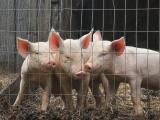Mar 29, 2012 (CIDRAP News) – Two studies yesterday confirmed the link between narcolepsy in Finnish children and the adjuvanted 2009 H1N1 pandemic vaccine Pandemrix and offered new details.
The two reports, published yesterday in Public Library of Science (PLoS) One, follow a September 2011 final report by Finnish officials confirming the link between narcolepsy and the AS03 adjuvanted vaccine that the country used exclusively during the pandemic. One explored Finland's narcolepsy incidence over the past several years, and another probed all narcolepsy cases reported in 2009 and 2010.
In the first study, researchers identified all narcolepsy cases reported by Finnish hospitals and sleep clinics in 2010 and compared the numbers with cases identified in the country's hospital discharge register from 2002 to 2009.
The overall incidence of narcolepsy in Finland between 2002 and 2009 in all ages was 0.79 per 100,000 people. For children under age 17 during the same period, it was 0.31 per 100,000.
However, the team found that 54 children were diagnosed as having the condition in 2010, putting the incidence at 5.3 per 100,000 that year, representing a 17-fold increase, which they said confirms a sudden increase in narcolepsy that the country saw in Finnish kids in 2010.
The 2010 incidence of narcolepsy in adults 20 and older, in contrast stayed the same as earlier levels, the group reported.
When investigators explored the clinical picture of the 54 children with narcolepsy in 2010, they found that 50 had received the pandemic vaccine before symptom onset, which started abruptly.
Forty-seven children had cataplexy, a sudden and transient loss of muscle tone, which began upon or shortly after excessive daytime sleepiness started. In addition, psychiatric symptoms were common in the children who had narcolepsy after pandemic vaccination. They also found that, of 32 children who had human leukocyte antigen (HLA) typing, all were positive for a genotype linked to narcolepsy.
The group said the possibility that the increased incidence could be related to increased awareness about narcolepsy in 2010 is unlikely, since parents had sought medical care for their children before news stories about the possible pandemic vaccine link surfaced.
Though narcolepsy is considered an immune-mediated autoimmune disease, they said the abrupt onset of the condition in the children is unusual for narcolepsy as well as other autoimmune diseases. "The incidence of many autoimmune diseases has increased over the past decades, but the rise has never been as abrupt and as strong as in the case of childhood narcolepsy in Finland in 2010," they wrote.
They noted that the high pandemic coverage rate—75% in Finnish children and adolescents—might explain the increased narcolepsy incidence, as could a host of other genetic or environmental factors. For example, they wrote that an inflammatory response provoked by the vaccine could have induced or accelerated preexisting autoimmunity in genetically predisposed kids.
Future studies are needed to sort out the role of other possible triggers and genetic factors, the group wrote.
The second report described a retrospective cohort study conducted in 2009 and 2010 of Finnish children born in 1991 through 2005, assessing vaccination data and identifying all new narcolepsy cases, based on expert classification.
Pandemic vaccine coverage in the cohort was 75%, and of 67 confirmed narcolepsy cases, researchers included 46 vaccinated and 7 unvaccinated children in their primary analysis. These numbers represent a 12.7-fold risk after Pandemrix vaccination that translates to a vaccine-attributable risk of 1 in 16,000.
Thirty-three of the children had been referred to specialists before reports on the suspected narcolepsy-vaccine link surfaced in the media.
They noted that the findings run counter to a Chinese study that found an increased narcolepsy risk in the wake of the 2009-10 pandemic season, even in youngsters who didn't receive the vaccine, but they noted that the pattern they found is consistent with a similar cohort study in Sweden.
The group also suggested that vaccines, especially adjuvanted ones, might induce bystander activation of immunological responses, with possible age-related differences. They also said that pandemic vaccination could have accelerated an ongoing disease process rather than triggering narcolepsy-related autoimmunity.
They also called for further studies to explore the underlying mechanisms and whether the adjuvanted vaccine link to narcolepsy can be shown in other populations.
Partinen M, Saarenpaa-Heikkila O, Ilveskloski I, et al. Increased incidence and clinical picture of childhood narcolepsy following the 2009 H1N1 vaccination campaign in Finland. PLoS One 2012 Mar 28 [Full text]
Nohynek H, Jokinen J, Partinen M, et al. AS03 adjuvanted AH1N1 vaccine associated with an abrupt increase in the incidence of childhood narcolepsy in Finland. PLoS One 2012 Mar 28 [Full text]
See also:
Sep 1, 2011, CIDRAP News story "Probe on narcolepsy-H1N1 vaccine link finds genetic risk factor"


















